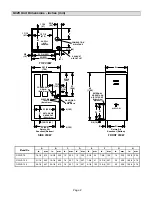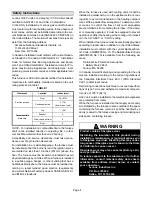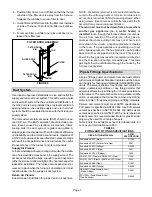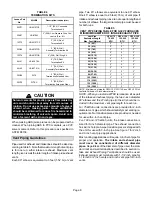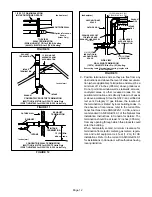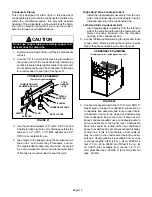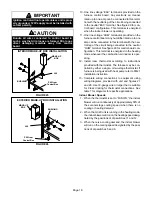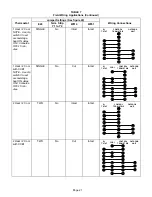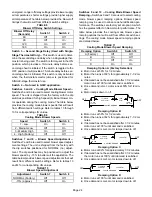
Page 11
4 - Intake and exhaust pipes should be placed as close
together as possible at termination end (refer to ilĆ
lustrations). Maximum separation is 3 inches (76
mm) on roof terminations and 6 inches (152 mm) on
side wall terminations.
5 - Exhaust piping must terminate straight out or up as
shown. In rooftop applications, a 2 inch X 1-1/2 inch
reducer for 2 inch venting, 3 inch x 2 inch reducer for
3 inch venting must be used on the exhaust piping at
the point where it exits the structure to improve the
velocity of exhaust away from the intake piping.
On roof terminations, the intake piping should termiĆ
nate straight down using two 90
°
elbows. See figure 8.
FIGURE 8
ROOF TERMINATION KIT
(15F75) LB-49107CC for 2 (51) Venting
(44J41) LB-65678A for 3 (76) Venting
UNCONDITIONED
ATTIC SPACE
1/2 (13) FOAM
INSULATION IN
UNCONDITIONED
SPACE
3 x 2 (76 x 51) OR
2 x 1-1/2 (51 x 38)
PVC REDUCER
3 (76) MAX.
12 (305) ABOVE
AVERAGE SNOW
ACCUMULATION
3 (76) OR
2 (51) PVC
PROVIDE SUPPORT
FOR INTAKE AND
EXHAUST LINES
8 (203) MIN
Inches (mm)
IMPORTANT
Do not use screens or perforated metal in intake
and exhaust terminations. Doing so will cause
freeze-ups and may block the terminations.
NOTE - If winter design temperature is below 32°F (0°C),
exhaust piping must be insulated with 1/2 inch (13 mm),
Armaflex or equivalent when run through unheated
space. Do not leave any surface area of exhaust pipe
open to outside air; exterior exhaust pipe must be insuĆ
lated with 1/2 inch (13 mm) Armaflex or equivalent. In exĆ
treme cold climate areas, 3/4 inch (19 mm) Armaflex or
equivalent is recommended. Insulation on outside runs of
exhaust pipe must be painted or wrapped to protect inĆ
sulation from deterioration.
NOTE - During extremely cold temperatures, below
approximately 20°F (6.67°C), units with long runs of
vent pipe through unconditioned space, even when inĆ
sulated, may form ice in the exhaust termination that
prevents the unit from operating properly. Longer run
times of at least 5 minutes will alleviate most icing probĆ
lems. Also, a heating cable may be installed on exhaust
piping and termination to prevent freezeĆups. Heating
cable installation kit is available from Lennox. See ConĆ
densate Piping section for part numbers.
NOTE - Avoid recirculation of exhaust back into the inĆ
take pipe.
6 - On field-supplied terminations for side wall exits, exĆ
haust piping should extend a maximum of 12 inches
(305 mm) beyond the outside wall. Intake piping
should be as short as possible. See figure 9.
FIGURE 9
1/2 (13) ARMAFLEX
INSULATION IN
UNCONDITIONED SPACE
2 (51) PVC
1-1/2 (38) PVC
12 (305) MIN.
2 X 1-1/2
(51 x 38)
PVC REDUCER
1/2 (13) ARMAFLEX
INSULATION
6 (152)
MAXIMUM
2 (51) PVC
COUPLING
8 (203)
MINIMUM
OUTSIDE
WALL
Inches (mm)
TOP VIEW
WALL RING KIT
(15J74) LB-49107CB for 2 (50.8) Venting
7 - On field-supplied terminations, a minimum separaĆ
tion distance between the end of the exhaust pipe
and the end of the intake pipe is 8 inches (203 mm).
8 - If intake and exhaust piping must be run up a side
wall to position above snow accumulation or other
obstructions, the piping must be supported every 3
feet (.91 m) as shown in figure 14. Refer to figures 13
and 15 for proper piping method. WTK wall terminaĆ
tion kit must be extended for use in this application.
See figure 18 or use kit WTKX shown in figure 19.
When exhaust and intake piping must be run up an
outside wall, the exhaust piping is reduced to 1 1/2
inches (38 mm) after the final elbow. The intake pipĆ
ing may be equipped with a 90
°
elbow turndown. UsĆ
ing turn-down will add 5 feet (1.5 m) to the equivalent
length of the pipe.


